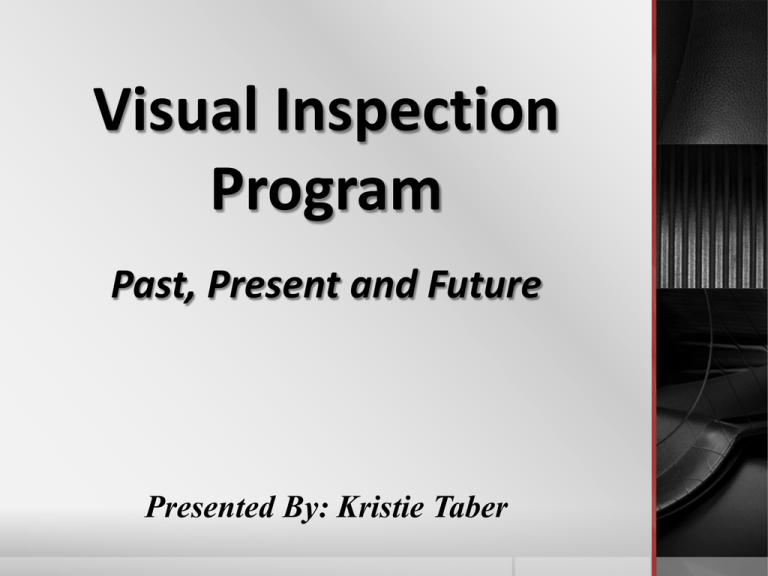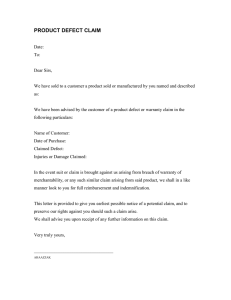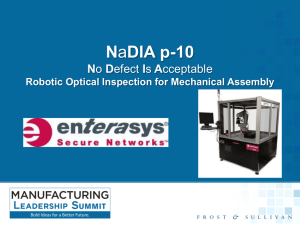Gilead Science`s Visual Inspection Program
advertisement

Visual Inspection Program Past, Present and Future Presented By: Kristie Taber Visual Inspection Program FDA and Annex I requirements Application of the Guidance Establishing Alert and Action Reject Limits Response to Exceeding Alert and Action Reject Limits Assessment of Defect Categorizes Particulate Matter Identification Program Challenges with Contract Manufacturing Sites FDA and Annex I Requirements FDA Guidance Review Defective units should be detected, and removed during inspection process. Safeguards should be in placed to preclude shipment of product that may lack container closure integrity and lead to non-sterility. If damage that is not readily detected leads to loss of container closure integrity, improved procedures should be rapidly implemented to prevent/detect such defects Any defects outside of specification established for in-process and final inspection are to be investigated. Annex 1 Review Parenteral products should be inspected individually for extraneous contamination and other defects. The inspection should be done under suitable and controlled conditions of illumination and background. Inspectors should pass regular eye-sight checks and be allowed frequent breaks. Inspection Results should be recorded. Inspectors should pass regular eye-sight checks and be allowed frequent breaks from inspection. Automated inspection system should be validated and the performance of the equipment. Application of the Guidance Application of the Guidance Dedicated Inspection areas/booths are equipped with black and white backgrounds. Justified light intensity suitable to support inspector qualification. Inspection area / equipment are routinely checked in a Preventive Maintenance program. Inspectors do not exceed qualified inspection rate. Frequent and defined eye breaks Annual eye-sight check and meet 20/20 (with or without corrective lenses) with no color blindness. Application of the Guidance (Cont.) Inspectors must demonstrate proficiency of removing defects from a seeded population of typical "in-house" defects. Inspectors must demonstrate proficiency to remove 100% of critical defects and 85% of all other defects and LT5% of the acceptable population. Defect libraries must include examples of all appropriate defect types found "in-house" for all products using actual product. Defect Library should have defined minimum and maximum % defects in the challenge set for inspector. Application of the Guidance (Cont.) Requirement for adding new defect types to the library, refreshing the defect library and annual assessment. Reject rate action limits should be established for each defect type as well as an overall batch reject rate which will trigger a formal documented, investigation. Reject rate alert limits should be trended and adverse trend should trigger a formal, documented investigation. When using two inspection types (manual and automated or semi-automated), an equivalency is established. Past Visual Inspection Program Past Visual Inspection Program Defect types were classified based on the corporate procedure. The visual inspection action limits were based on historical results. Particulate Matter Defects found during visual inspection were rejected. Vial Defect Classification Assessment Vial Defect Classification Assessment The objective of the risk assessment was to provide the methodology for evaluating rejects and assigning defect classifications encountered during in-processing visual inspection. Vial Defect Category Risk Analysis A risk analysis was performed by a multidisciplinary group for each vial inspection defect classification. Identify known defects by product. Map the process with potential sources that can contribute / cause the defect. Define the acceptance criteria for Risk Class and Risk Priority Classification prior to performing the assessment. Determination Of Risk Class Determination of Risk Class The Risk Class is determined by assessing the Criticality of each defect against the Probability of Occurrence. Identify the Defect Types for the process by product type. Determine the Where the Defect Can be Found In the process. Potential Cause of the Defects Determination of Risk Class Criticality Classification: Each defect was evaluated to determine the potential impact to the patient as a result of receiving product with the specified defect. Probability of Occurrence Classification: Each defect was evaluated to determine the probability of the defect occurring in the process based on process controls and historical in-process inspection results. Determination of Criticality Classification Risk Criticality Criticality Classification Failure has no effect on the patient or system. Unnoticed Failure is not likely to injure the patient or Nuisance result in loss of product efficacy. Failure could result in minor injury to patient Non-Serious Harm and some loss of product efficacy. Failure could result in moderate injury to Detrimental patient and significant loss of product efficacy. Failure could result in death or major Dangerous permanent injury to the patient. Determination of Probability of Occurrence Risk Failure almost never occurs; no record of occurrence Failure is unlikely to occur Probability Rating Description Remote 1 Low 3 Failure may occur Failure likely to occur Medium High 5 7 Failure has a high likelihood to occur Certain 10 Risk Classification Assessment Environment Related 3 Intrinsic Particulate Matter Operator Related 2 Extrinsic Particulate Matter Process Related Obvious Meltback or Collapsed Cake Equipment Related 1 Quality of Raw Materials Failure Mode(s) Quality of Components No. 1 2 3 4 5 6 x x x x x x x x x Comment Probability Risk Criticality of Class Occurrence • Equipment Related: Mechanical failure NonProcess Related: Inadequate Cycle Serious Parameters Harm • Operator Related: Human required intervention • Environmental Related: Inadequate material Dangerous transfer procedures or pressure differential requirements Low Major B Low Critical • Quality of Components Related: Supplier • Quality of Raw Materials Related: Supplier • Quality Equipment Related: Mechanical Set Up or Failure Remote Major A • Process Related: Inadequate transfer Dangerous • Operator Related: Operator intervention or Error • Environment Related: Inadequate environment controls or alarms Risk Class Classification Based on the Criticality and Probability of Occurrence, a Risk Class Classification was determined for each type of defect Risk Class Criticality / Probability Of Occurrence Dangerous Detrimental Non-Serious Harm Nuisance Unnoticed Certain Critical Critical Major A Major B Minor High Critical Critical Major A Major B Minor Medium Critical Major A Major B Minor Minor Low Critical Major A Major B Minor Minor Remote Major A Major B Minor Minor Minor Determination Of Risk Priority Determination of Detectability Risk/Hazard Detectability Detectability There are automated detection systems and “shut-offs” or constraints in place to prevent the failure. Almost Certain Failures for which no known mechanism of detection is None or Remote available or for which known detection methods are not Chance feasible. Failures detectable by manual inspection or manual monitoring but for which no formal process establishes Unlikely Chance such activities so detection is left to chance. There is a process in place for double checks or inspection but it is not automated, is applied only to a Moderate Chance sample or relies on vigilance. There is an automated or manual 100% inspection for High Chance the failure Determination of Risk Priority Risk Priority is based on the Risk Class (accounts for severity and frequency of occurrence) and Detectability of Each Defect. Detectability Classification: Each defect was evaluated to determine the potential for the process, equipment and inspectors to detect the defective vial. The combinations of detection controls for the process were evaluated for process controls, equipment controls (alarms), inspection process and historical events for failed AQL inspection. Determining Risk Priority Defect Category Risk Class Detectability Detection Controls • 100% inspection for visible particles Rationale Risk Priority • Sub-visible particles can not be measured based on the nature of the product. (Liposome Product) • Identification of all visible particles. Extrinsic Moderate During lyophilization process • Historically, the inspectors Particulate Critical Critical Chance particles rise to the top or settle have been able to detect Matter to the bottom of the cake. particles down to > 50µm Therefore, there is a moderate • The yellow color of the cake chance of detecting particles > enhances the detection of dark 50µm in size. and light colored particles. Incorrect Critical product High Chance • Line Clearance • Trained Operators • Performer / Verifier Requirements • Line Configuration Limits Vial • Size for Dabrico • Qualified Visual Inspection • AQL Inspection • Historically, the product lines are unique in color, vial size, and type of vial. Major A Risk Priority Classification Risk Class / Detectability Critical Major A Major B Minor No or Remote Chance Critical Critical Major A Major B Unlikely Chance Critical Critical Major A Minor Moderate Chance Critical Major A Major B Minor High Chance Major A Major B Minor Minor Almost Certain Major B Major B Minor Minor Quality Assurance’s Implementation The Defect Assessment The Quality Assurance visual inspection program (procedures) was updated to reflect defect classification solely based on the Risk Class Classification. The defects potential impact to the patient and likelihood for the defect to occur (i.e. consideration is not given to detectability). Manufacturing’s Implementation The Defect Assessment The Manufacturing’s visual inspection program (procedures, master production records, inspector qualification program) was updated to reflect defect classification based on the Risk Priority Classification. Risk Priority classification accounts for the Risk Class and the ability to the process to control and detect the defect. Comparison Between QA AQL Inspection Defect Classification and Manufacturing 100% Visual Inspection Defect Classification Defect Type AQL Defect Classification Based on Risk Class Manufacturing 100% Defect Classification Updated Based on Risk Priority Obvious Melt back or Collapsed Cake Major B Minor Extrinsic Particulate Matter Critical Critical Intrinsic Particulate Matter Major A Major A Incorrect product Critical Major A Establishing Defect Reject Alert and Action Limits Establishing Limits Defect Type Alert Limits Response to exceeding alert limits. Defect Category Action Limits Response to exceeding category action limits. Overall Defect Reject Action Limits Response to Overall Reject Rates Visual Inspection Defect Type Alert Limits Established per defect type Based on historical trend data Evaluated annually for confirming limits Exceeding alert limits require a brief investigation, tracking and trending Visual Inspection Defect Category Reject Rate Action Limits Specified per defect classification (i.e. critical, major and minor). Defect reject rates limits were developed based on Acceptance Quality Levels (AQLs) and the assumed inspection efficiency. We assume that a single visual inspection is minimally 70% efficient and combined it with the AQLs of 0.15% (Critical), 1% (Major) and 4% (Minor). Visual Inspection Defect Category Reject Rate Action Limits This alignment between inspection efficiency and the AQL values assures that the visual inspected product will pass the Quality Inspection. The actual calculation sets the visual inspection reject rate action limits such that the visual inspection AQL values represents 100-70% of those limits. Calculation of Proposed Reject Rates The AQLs values and the corresponding visual inspection limits were calculated by multiplying those values by where 0.70 corresponds to the assumed 70% efficiency Response to Exceeding Reject Rates Exceeding the defect alert limits require a brief investigation, tracking and trending. Exceeding the defect category action limits require an investigation and heightened AQL. Exceeding the overall reject requires an investigation, Material Review Board review, and QA Senior Management authorization prior to product disposition. Particulate Matter Identification Program Particulate Matter Identification Program The qualification program for visual inspection includes of particulate defects found in product. Particulate Matter defects found during finished product visual inspection are rejected from the population and identified. The response to particulate matter defect identification results has been clearly defined. Particulate Matter defects are trended quarterly by product and process. Lot release requires particulate matter identification and categorization prior to disposition. Particulate Matter Identification Response Process Flow Challenges with Contract Manufacturing Sites Challenges with Contract Manufacturing Sites Differences in the visual inspection program Visual Inspection Method Lighting Intensity of Inspection Stations Inspection Environment Acceptance Criteria Response to Exceeding Limits Trending of In-Process Rejects Trending of In-Process Rejects Categorization of rejects found during the manufacturing process. Establish limits for categories of in-process rejects. Monitor and trend the reject categories Establish a procedure for response, monitoring and trending of in-process rejects. Quality Plan for the Future Visual Inspection Program Quality Plan Visual Inspection Program Corporate Policy for Standard Aseptic Processing Requirements Creating a corporate procedure with the minimum requirements for visual inspection program. Upcoming Changes to Particulate Matter Program Building a known particulate matter defect library by walking the process and collecting samples. Incoming materials particulate matter identification requirements. Risk and Material compatibility assessments for each particulate matter defect type. Implementing reconstitution of lyophilzed product as part of product inspection process. Quality Plan Visual Inspection Program (Cont) Upcoming Changes Visual Inspection Program Validating the Leak Detection System for inspecting product to ensure the vials are integral. This inspection will be performed at minimum two days after the unload process and prior to product inspection process. Thank you


